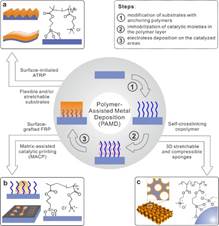时间:2015年6月18日星期四下午 2:30点
地点:浙大玉泉校区教三301会议室
报告题目:
Polymer-assisted metal deposition (PAMD ) for Soft Electronics
摘要
One solution-processible strategy, namely polymer-assisted metal deposition (PAMD), has been developed in our group, which allows ambient fabrication of flexible, foldable, stretchable, compressible, and wearable metal (especially Cu) conductors with very high conductivity. As shown inFigure 1, the key innovation of PAMD is the use of a thin and functional polymer interfacial layer that assists electroless deposition (ELD) of metal thin films and patterns (Au, Ag, Cu, and Ni) on soft substrates such as plastics, elastomers, papers, and polyurethane sponges. Such a polymer interfacial layer offers remarkable adhesion between metal and substrate, which is critical for enhancing the mechanical durability of the metal layer upon large deformation. In general, PAMD includes three steps. First, fundtional interfacial polymer such as (i.e., poly[2-(methacryloyloxy)ethyl] trimethylammonium chloride (PMETAC)) are anchored on various substrates at ambient conditions. And then, the catalyst precusors are immobilized into the polymer layer by ion exchange. Finally, the ELD process is proformed and corresponding thin metal films are obtained. Importantly, PAMD is compatible with versatile substrates. Moreover, the patterned metal films can be readily fabricated by patterning the PMETAC nanoplatform or catalyst precusors. On the basis of these advantages, PAMD is employed to fabricate flexible, foldable, stretchable, and wearable metal conducting sheets (Figure 1a), patterned flexible and stretchable metal interconnects (Figure 1b), and stretchable and compressible 3D metal sponges (Figure 1c), respectively.

Fig. 1. Schematic illustration of polymer-assisted metal deposition (PAMD) and its various applications.
个人简介
Dr. Zijian Zheng received his B. Eng. in Polymer Materials and Engineering at Tsinghua University (Beijing) in 2003, and Ph. D. in Chemistry at the University of Cambridge (UK) in 2007. He was a Postdoctoral Fellow at Northwestern University (USA) prior to joining ITC. His research focuses on controlling the surface architecture at the nanometer length scale. To date, he has published more than 50 papers in international renowned journals, such as Science, Angewandte Chemie, Advanced Materials, Nature Communications, Journal of the American Chemical Society, and Nano Letters.
Research Interest and Expertise:
surface patterning, surface chemistry, polymer brushes, polymer science, self-assembly, flexible/stretchable/wearable electronics, organic electronics, graphene electronics
Publications (2006-now): >55 journal papers in total. 26 papers published in IF≥10 journals (1 Science; 1 Nature Communications; 1 NPG Asian Materials; 7 Advanced Materials; 6 Advanced Functional Materials; 3 Angew Chem; 2 JACS; 3 Nano Letters; 1 PNAS; 1 ACS Nano), and 9 papers published in IF≥7 journals (9 Small).







